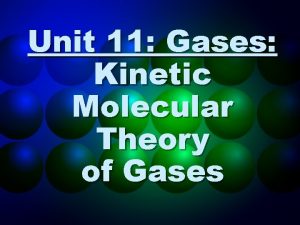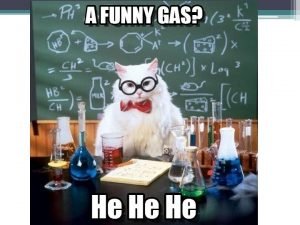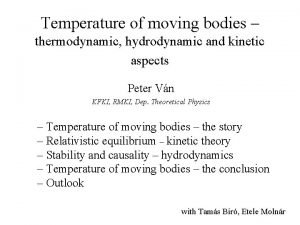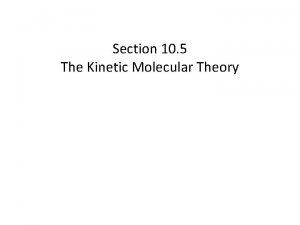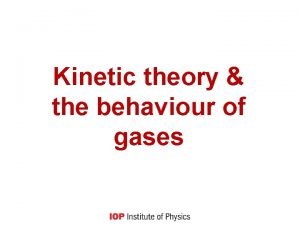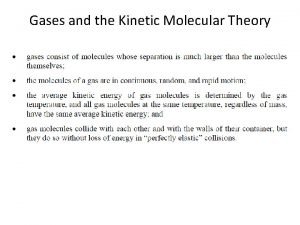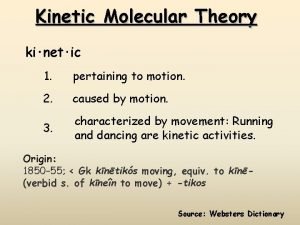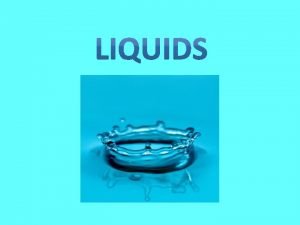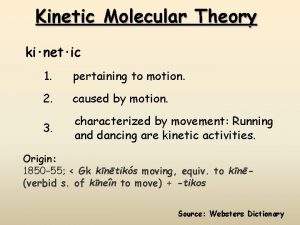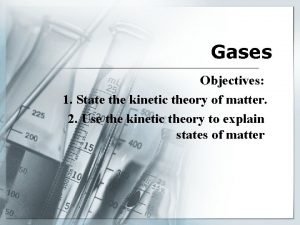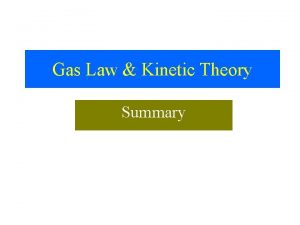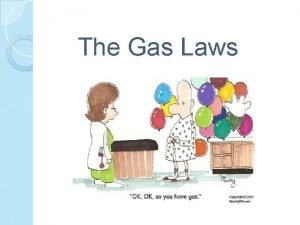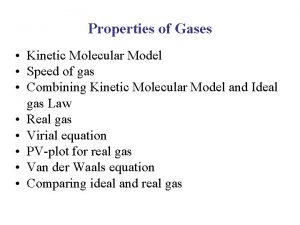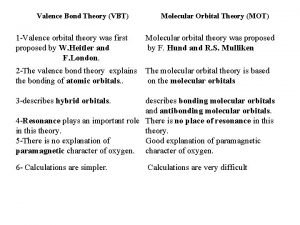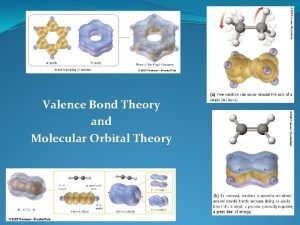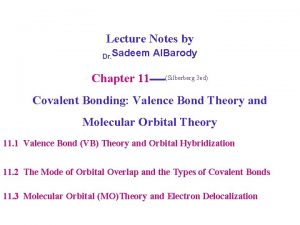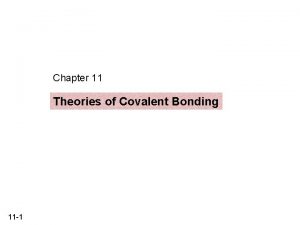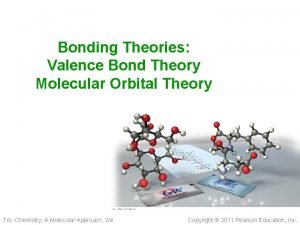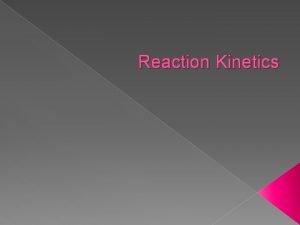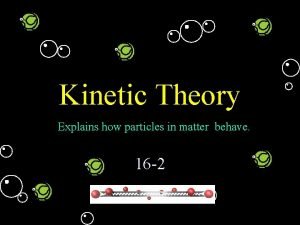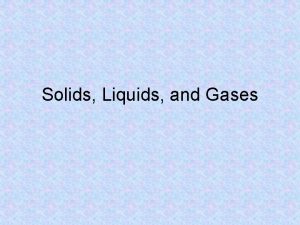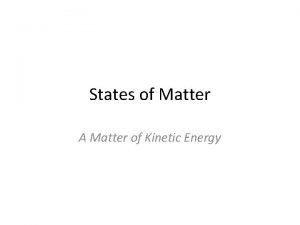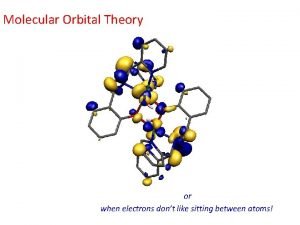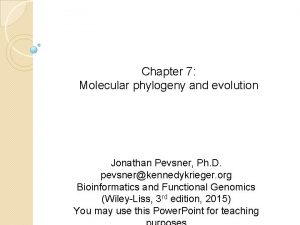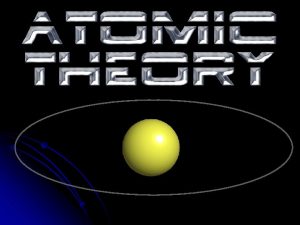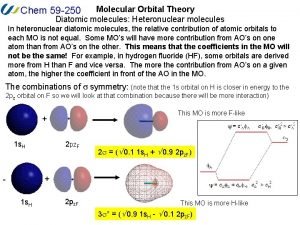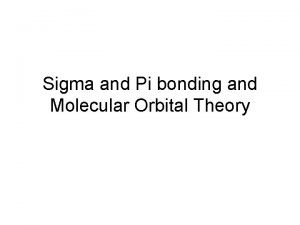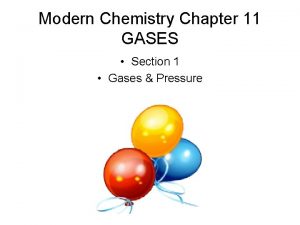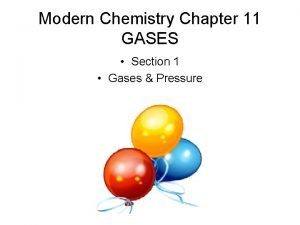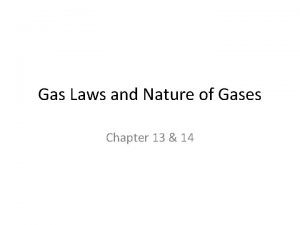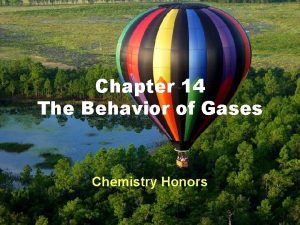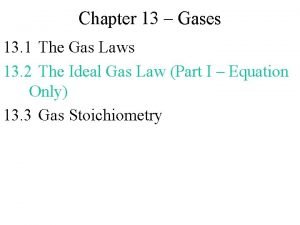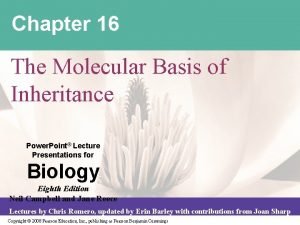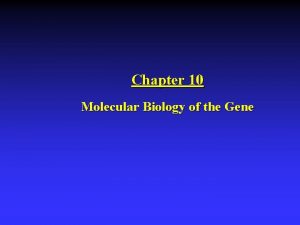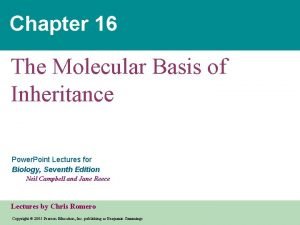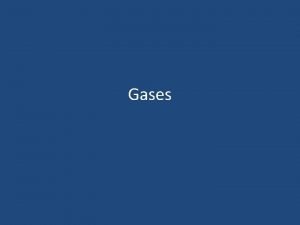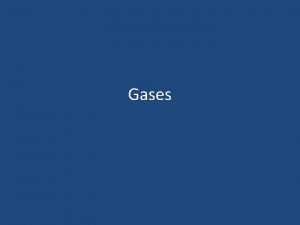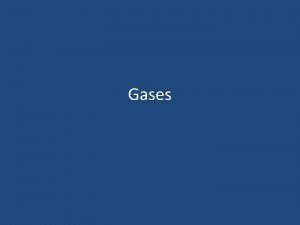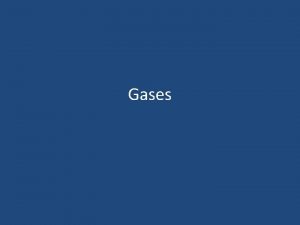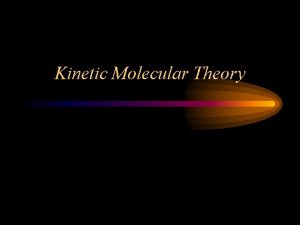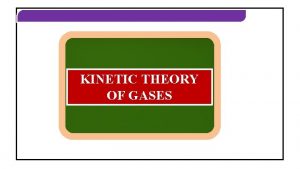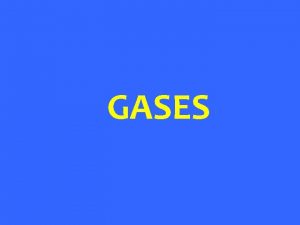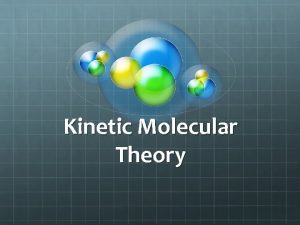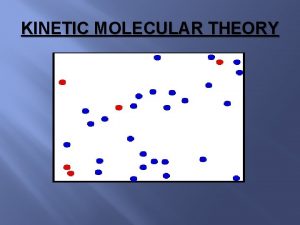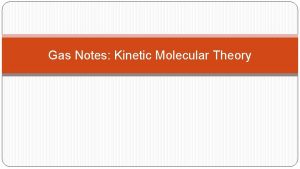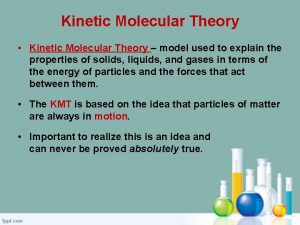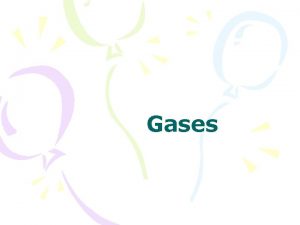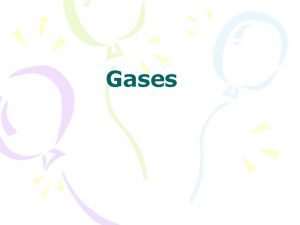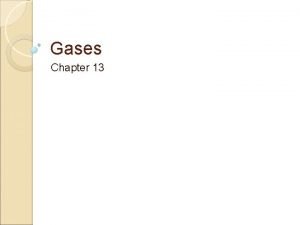Chapter 11 Gases 11 2 Kinetic Molecular Theory























































- Slides: 55

Chapter 11 Gases

11. 2 Kinetic Molecular Theory: A Model for Gases �A model for understanding the behavior of gases is the kinetic molecular theory. � This model predicts the correct behavior for most gases under many conditions. � Like other models, the kinetic molecular theory is not perfect and breaks down under certain conditions. � We focus on conditions where it works well. © 2012 Pearson Education, Inc.

11. 2 Kinetic Molecular Theory: A Model for Gases 1. 2. 3. 4. A gas is a collection of particles in constant, straight-line motion. Gas particles do not attract or repel each other— they do not interact. There is a lot of space between gas particles compared with the size of the particles themselves. The average kinetic energy—energy due to motion—of gas particles is proportional to the temperature of the gas in kelvins. This means that as the temperature increases, the particles move faster and therefore have more energy. © 2012 Pearson Education, Inc.

11. 2 Kinetic Molecular Theory: A Model for Gases Kinetic molecular theory is consistent with the properties of gases. • Gases are compressible. • Gases assume the shape and volume of their container. • Gases have low densities in comparison with liquids and solids. © 2012 Pearson Education, Inc.

Compressibility of gases (left): Gases are compressible because there is so much empty space between gas particles. Incompressibility of liquids (right): Liquids are not compressible because there is so little space between the liquid particles. © 2012 Pearson Education, Inc.

A gas assumes the shape of its container. Since the attractions between molecules in a gas are negligible, and since the particles are in constant motion, a gas expands to fill the volume of its container. © 2012 Pearson Education, Inc.

Gases have a low density in comparison with solids and liquids because there is so much empty space between the atoms or molecules in a gas. � If the liquid water in a 350 -m. L (12 -oz) can of soda were converted to steam (gaseous water), the steam would occupy a volume of 595 L (the equivalent of 1700 soda cans). � The density of steam at 1 atm pressure and 100°C is about 0. 0006 g/cm 3. � © 2012 Pearson Education, Inc.

11. 3 Pressure: The Result of Constant Molecular Collisions �Pressure is the result of the constant collisions between the atoms or molecules in a gas and the surfaces around them. �Because of pressure, we can drink from straws, inflate basketballs, and move air into and out of our lungs. �Variation in pressure in Earth’s atmosphere creates wind, and changes in pressure help predict weather. Pressure is all around us and even inside us. © 2012 Pearson Education, Inc.

11. 3 Pressure: The Result of Constant Molecular Collisions � The pressure exerted by a gas sample is defined as the force per unit area that results from the collisions of gas particles with surrounding surfaces. � The pressure exerted by a gas depends on several factors, including the number of gas particles in a given volume. © 2012 Pearson Education, Inc.

� Since pressure is a result of collisions between gas particles and the surfaces around them, the amount of pressure increases when the number of particles in a given volume increases. � The fewer the gas particles, the lower the pressure. © 2012 Pearson Education, Inc.

Units of Pressure �The simplest unit of pressure is the atmosphere (atm), the average pressure at sea level. �The SI unit of pressure is the pascal (Pa), defined as 1 newton (N) per square meter. �The pascal is a much smaller unit of pressure; 1 atm is equal to 101, 325 Pa. © 2012 Pearson Education, Inc.

�A third unit of pressure, the millimeter of mercury (mm Hg), originates from how pressure is measured with a barometer. � Average atmospheric pressure at sea level pushes a column of mercury to a height of 760 mm (29. 92 in. ). � Since mercury is 13. 5 times as dense as water, it is pushed up (1/13. 5) times as high as water by atmospheric pressure. © 2012 Pearson Education, Inc.

Common Units of Pressure � The units of pressure are summarized in Table 11. 1 and inside the back cover of the textbook. � Useful when completing homework problems. © 2012 Pearson Education, Inc.

Convert 0. 311 atm to millimeters of mercury (mm Hg). SOLUTION MAP: SOLUTION: © 2012 Pearson Education, Inc.

11. 4 Boyle’s Law: Pressure and Volume � The pressure of a gas sample depends, in part, on its volume. � If the temperature and the amount of gas are constant, the pressure of a gas sample increases for a decrease in volume and decreases for an increase in volume. © 2012 Pearson Education, Inc.

11. 4 Boyle’s Law: Pressure and Volume �The relationships between gas properties are described by gas laws. �The relationship between volume and pressure was discovered by Robert Boyle (1627– 1691) and is called Boyle’s law. �Boyle’s law assumes constant temperature and a constant number of gas particles. �Boyle’s law: The volume of a gas and its pressure are inversely proportional. © 2012 Pearson Education, Inc.

(a) Adding mercury to the J-tube causes the pressure on the gas sample to increase and its volume to decrease. (b) A plot of the volume of a gas as a function of pressure. © 2012 Pearson Education, Inc.

Kinetic molecular theory explains the observed change in pressure. If the volume of a gas sample is decreased, the same number of gas particles is crowded into a smaller volume, causing more collisions with the walls of the container and therefore increasing the pressure. © 2012 Pearson Education, Inc.

EXAMPLE 11. 2 Boyle’s Law: P 1 V 1 = P 2 V 2 �A cylinder equipped with a moveable piston has an applied pressure of 4. 0 atm and a volume of 6. 0 L. � What is the volume of the cylinder if the applied pressure is decreased to 1. 0 atm? � GIVEN: P 1 = 4. 0 atm V 1= 6. 0 L P 2 = 1. 0 atm � FIND: V 2 � RELATIONSHIPS USED: P 1 V 1 = P 2 V 2 © 2012 Pearson Education, Inc.

� SOLUTION: MAP:

11. 5 Charles’s Law: Volume and Temperature �Why does hot air rise? �Hot air rises because the volume of a gas sample at constant pressure increases with increasing temperature. �As long as the amount of gas (and therefore its mass) remains constant, warming it decreases its density because density is mass divided by volume. �A lower-density gas floats in a higher-density gas just as wood floats in water. © 2012 Pearson Education, Inc.

11. 5 Charles’s Law: Volume and Temperature � Heating the air in a balloon makes it expand (Charles’s law). � As the volume occupied by the hot air increases, its density decreases, allowing the balloon to float in the cooler, denser air that surrounds it. © 2012 Pearson Education, Inc.

Keep the pressure of a gas sample constant and measure its volume at a number of different temperatures. © 2012 Pearson Education, Inc.

The volume of a gas increases linearly with increasing temperature. The volume of a gas decreases linearly with decreasing temperature. �We can predict an important property of matter by extending the line on our plot backward from the lowest measured point—a process called extrapolation. �Our extrapolated line shows that the gas should have a zero volume at – 273 °C, which corresponds to 0 K, the coldest possible temperature. �Our extrapolated line shows that below – 273 °C our gas would have a negative volume, which is physically impossible. �For this reason, we refer to 0 K as absolute zero —colder temperatures do not exist. © 2012 Pearson Education, Inc.

11. 5 Charles’s Law: Volume and Temperature �J. A. C. Charles (1746– 1823), a French mathematician and physicist, was the first person to carefully quantify the relationship between the volume of a gas and its temperature. Charles was among the first people to ascend in a hydrogenfilled balloon. �The law he formulated is called Charles’s law. �Charles’s law assumes constant pressure and a constant amount of gas. �Charles’s law: The volume (V) of a gas and its Kelvin temperature (T) are directly proportional. © 2012 Pearson Education, Inc.

11. 5 Charles’s Law: Volume and Temperature �If two variables are directly proportional, then increasing one by some factor increases the other by the same factor. �When the temperature of a gas sample (in kelvins) is doubled, its volume doubles. �When the temperature is tripled, its volume triples, and so on. �The observed relationship between the temperature and volume of a gas follows from kinetic molecular theory. �If the temperature of a gas sample is increased, the gas particles move faster, and if the pressure is to remain constant, the volume must increase. © 2012 Pearson Education, Inc.

If temperature is changed when a balloon is moved from an icewater bath into a boiling-water bath, the gas molecules inside it move faster due to the increased temperature. If the external pressure remains constant, the volume will change when the molecules expand the balloon and collectively occupy a larger volume.

� Charles’s law can be used to calculate the volume of a gas following a temperature change. � Charles’s law can be used to calculate the temperature of a gas following a volume change. � The pressure and the amount of gas are constant. All temperatures must be expressed in kelvins. © 2012 Pearson Education, Inc.

A sample of gas has a volume of 2. 80 L at an unknown temperature. When the sample is submerged in ice water at 0 °C its volume decreases to 2. 57 L. What was its initial temperature (in kelvins and in Celsius)? � GIVEN: V 1 = 2. 80 L V 2 = 2. 57 L t 2 = 0 °C FIND: T 1 and t 1 � SOLUTION MAP: � RELATIONSHIPS USED:

SOLUTION: © 2012 Pearson Education, Inc.

11. 6 The Combined Gas Law: Pressure, Volume, and Temperature � Boyle’s law shows how P and V are related at constant temperature, and Charles’s law shows how V and T are related at constant pressure. � What if two of these variables change at once? © 2012 Pearson Education, Inc.

The combined gas law applies only when the amount of gas is constant. The temperature must be expressed in kelvins. �A sample of gas has an initial volume of 158 m. L at a pressure of 735 mm Hg and a temperature of 34 °C. � If the gas is compressed to a volume of 108 m. L and heated to a temperature of 85 °C, what is its final pressure in millimeters of mercury? � GIVEN: P 1 = 735 mm Hg t 1 = 34 °C V 1 = 158 m. L t 2 = 85 °C V 2 = 108 m. L FIND: P 2 = ? mm Hg © 2012 Pearson Education, Inc.

� SOLUTION: © 2012 Pearson Education, Inc.

11. 7 Avogadro’s Law: Volume and Moles � What happens when the amount of gas changes? � Make several measurements of the volume of a gas sample (at constant temperature and pressure) while varying the number of moles in the sample. © 2012 Pearson Education, Inc.

�The volume of a gas sample increases linearly with the number of moles in the sample. �This relationship was first stated formally by Amadeo Avogadro (1776– 1856) and is called Avogadro’s law. �Avogadro’s law assumes constant temperature and pressure. �Avogadro’s law: The volume of a gas and the amount of the gas in moles (n) are directly proportional. © 2012 Pearson Education, Inc.

Avogadro’s law: The volume of a gas and the amount of the gas in moles (n) are directly proportional. � As you exhale into a balloon, you add gas molecules to the inside of the balloon, increasing its volume. © 2012 Pearson Education, Inc.

A 4. 8 -L sample of helium gas contains 0. 22 mol of helium. How many additional moles of helium gas must be added to the sample to obtain a volume of 6. 4 L? � GIVEN: � SOLUTION: V 1 = 4. 8 L n 1 = 0. 22 mol V 2 = 6. 4 L FIND: n 2 = ? mol © 2012 Pearson Education, Inc.

11. 8 The Ideal Gas Law: Pressure, Volume, Temperature, and Moles � Boyle’s law, Charles’s law, and Avogadro’s law can be combined into a single law. Factor in “R” a proportionality constant © 2012 Pearson Education, Inc.

11. 8 The Ideal Gas Law: Pressure, Volume, Temperature, and Moles �The ideal gas law: PV = n. RT �The value of R, the ideal gas constant, is: �Each • • of the quantities in the ideal gas law must be expressed in the units within R. Pressure (P) must be expressed in atmospheres. Volume (V) must be expressed in liters. Amount of gas (n) must be expressed in moles. Temperature (T) must be expressed in kelvins. © 2012 Pearson Education, Inc.

© 2012 Pearson Education, Inc.

EXAMPLE 11. 6 The Ideal Gas Law Calculate the volume occupied by 0. 845 mol of nitrogen gas at a pressure of 1. 37 atm and a temperature of 315 K. GIVEN: n = 0. 845 mol P = 1. 37 atm T = 315 K CONSTANT: R FIND: V � SOLUTION: © 2012 Pearson Education, Inc.

Molar Mass of a Gas from the Ideal Gas Law Use the ideal gas law in combination with mass measurements. A sample of gas has a mass of 0. 136 g. Its volume is 0. 112 L at a temperature of 298 K and a pressure of 1. 06 atm. Find its molar mass. GIVEN: m = 0. 136 g V = 0. 112 L T = 298 K P = 1. 06 atm CONSTANT: R FIND: n and molar mass (mass/moles) � SOLUTION:

Gases are not always acting ideally. © 2012 Pearson Education, Inc.

11. 9 Partial Pressures in Mixtures of Gases � According to the kinetic molecular theory, each of the components in a gas mixture acts independently of the others. � The pressure due to any individual component in a gas mixture is called the partial pressure of that component. � The partial pressure of any component is that component’s fractional composition times the total pressure of the mixture. � The air in our atmosphere is a mixture containing 78% nitrogen, 21% oxygen, 0. 9% argon, 0. 04% carbon dioxide, and a few other gases in smaller amounts. � The nitrogen molecules in air exert a certain pressure— 78% of the total pressure—that is independent of the presence of the other gases in the mixture. � The oxygen molecules in air exert a certain pressure— 21% of the total pressure—that is also independent of the presence of the other gases in the mixture. © 2012 Pearson Education, Inc.

Partial Pressures � The fractional composition is the percent composition divided by 100. � Partial pressure of a component = Fractional composition of a component × Total pressure. © 2012 Pearson Education, Inc.

Partial Pressures Dalton’s law of partial pressures: Ptot = Pa + Pb + Pc + … where Ptot is the total pressure and Pa, Pb, Pc are the partial pressures of the components. For 1 atm air: Ptot = PN 2 + PO 2 + PAr = 0. 78 atm + 0. 21 atm + 0. 01 atm = 1. 00 atm © 2012 Pearson Education, Inc.

EXAMPLE 11. 9 Total Pressure and Partial Pressure A mixture of helium, neon, and argon has a total pressure of 558 mm Hg. The partial pressure of helium is 341 mm Hg and the partial pressure of neon is 112 mm Hg. What is the partial pressure of argon? Ptot PAr = PHe + PNe + PAr = Ptot − PHe − PNe = 558 mm Hg − 341 mm Hg − 112 mm Hg = 105 mm Hg © 2012 Pearson Education, Inc.

EXAMPLE 11. 10 Calculate the partial pressure of oxygen that a diver breathes with a heliox mixture containing 2. 0% oxygen at a depth of 100 m where the total pressure is 10. 0 atm. GIVEN: O 2 percent = 2. 0% Ptot = 10. 0 atm FIND: P O 2 SOLUTION: © 2012 Pearson Education, Inc.

When a gas from a chemical reaction is collected through water, water molecules become mixed with the gas molecules. The pressure of water vapor in the final mixture is the vapor pressure of water at the temperature at which the gas is collected. © 2012 Pearson Education, Inc.

Hydrogen gas was collected over water at a total pressure of 758 mm Hg and a temperature of 25 °C. What is the partial pressure of the hydrogen gas? We look up the partial pressure of water at 25 °C = 23. 8 mm Hg. Ptot = PH 2 + PH 2 O 758 mm Hg = PH 2 + 23. 8 mm Hg PH 2 = 758 mm Hg − 23. 8 mm Hg PH 2 = 734 mm Hg © 2012 Pearson Education, Inc.

11. 10 Gases in Chemical Reactions �In reactions involving gaseous reactants or products, the amount of gas is often specified in terms of its volume (V) at a given temperature (T) and pressure (P). �Use the ideal gas law to convert pressure, volume, and temperature to moles. �Use the stoichiometric coefficients to convert to other quantities in the reaction. © 2012 Pearson Education, Inc.

How many moles of NH 3 are formed by the complete reaction of 2. 5 L of hydrogen at 381 K and 1. 32 atm? Assume that there is more than enough N 2. GIVEN: V = 2. 5 L CONSTANT: R T = 381 K P = 1. 32 atm (of H 2) FIND: mol NH 3 SOLUTION: © 2012 Pearson Education, Inc.

Molar Volume at Standard Temperature and Pressure �The volume occupied by 1 mol of gas at 0 °C (273. 15 K) and 1 atm is 22. 4 L. �These conditions are called standard temperature and pressure (STP). �The volume occupied by 1 mol of gas under these conditions is called the molar volume of an ideal gas at STP. �Under standard conditions (STP), use this ratio as a conversion factor: 1 mol : 22. 4 L © 2012 Pearson Education, Inc.

One mole of any gas at standard temperature and pressure (STP) occupies 22. 4 L. © 2012 Pearson Education, Inc.

Calculate the number of liters of CO 2 gas that forms at STP when 0. 879 moles of Ca. CO 3 undergoes this reaction: Ca. CO 3(s) Ca. O(s) + CO 2(g) GIVEN: 0. 879 mol Ca. CO 3 FIND: CO 2(g) in liters SOLUTION MAP: SOLUTION:
 Kinetic molecular theory
Kinetic molecular theory Kinetic particle theory o level questions
Kinetic particle theory o level questions Kinetic theory of gases
Kinetic theory of gases Postulates of kinetic theory
Postulates of kinetic theory Kinetic theory
Kinetic theory Write postulates of kinetic theory of gases
Write postulates of kinetic theory of gases Write postulates of kinetic theory of gases
Write postulates of kinetic theory of gases Kinetic theory of gases
Kinetic theory of gases Molecular theory of gases and liquids
Molecular theory of gases and liquids Kinetic molecular theory of solid
Kinetic molecular theory of solid Kinetic molecular theory volume
Kinetic molecular theory volume Kinetic molecular theory of liquids and solids
Kinetic molecular theory of liquids and solids Kinetic molecular theory of liquids
Kinetic molecular theory of liquids Postulates of kinetic molecular theory
Postulates of kinetic molecular theory Kinetic theory def
Kinetic theory def Timeline of kinetic molecular theory
Timeline of kinetic molecular theory Charles law in terms of kinetic molecular theory
Charles law in terms of kinetic molecular theory Avogadro's law
Avogadro's law Kinetic molecular theory formula
Kinetic molecular theory formula Kinetic molecular theory
Kinetic molecular theory Tenets of kinetic molecular theory
Tenets of kinetic molecular theory Qumica
Qumica Mot of no
Mot of no Molecular orbital theory and valence bond theory
Molecular orbital theory and valence bond theory Valence bond theory and molecular orbital theory
Valence bond theory and molecular orbital theory Theories of covalent bonding
Theories of covalent bonding Hcn mo diagram
Hcn mo diagram Covalent bond boiling point
Covalent bond boiling point Ionic covalent metallic
Ionic covalent metallic Giant molecular structure vs simple molecular structure
Giant molecular structure vs simple molecular structure The kinetic theory of matter states that
The kinetic theory of matter states that Kinetic theory of matter definition
Kinetic theory of matter definition Kinetic theory of matter
Kinetic theory of matter An explanation of how particles in matter behave
An explanation of how particles in matter behave The attraction between particles gives solids a definite
The attraction between particles gives solids a definite What is a kinetic theory of matter
What is a kinetic theory of matter Molecular clock theory
Molecular clock theory Molecular orbital theory
Molecular orbital theory Neutral theory of molecular evolution notes
Neutral theory of molecular evolution notes Atomic molecular theory
Atomic molecular theory Heteronuclear mo diagram
Heteronuclear mo diagram How to memorize vsepr theory
How to memorize vsepr theory Sigma orbital and pi orbital
Sigma orbital and pi orbital Frontier molecular orbital theory
Frontier molecular orbital theory Law of combining volumes
Law of combining volumes Chapter 11 review gases section 1
Chapter 11 review gases section 1 Ideal gas law equation example
Ideal gas law equation example 14 the behavior of gases
14 the behavior of gases Section 13.2 the combined gas law and avogadro's principle
Section 13.2 the combined gas law and avogadro's principle Chapter 14 solids liquids and gases worksheet answers
Chapter 14 solids liquids and gases worksheet answers Calculate force of friction
Calculate force of friction Chapter 16 the molecular basis of inheritance
Chapter 16 the molecular basis of inheritance Chapter 12 section 1 dna the genetic material
Chapter 12 section 1 dna the genetic material Chapter 12 section 1 molecular genetics answer key
Chapter 12 section 1 molecular genetics answer key Molecular biology of the gene chapter 10
Molecular biology of the gene chapter 10 Chapter 16 the molecular basis of inheritance
Chapter 16 the molecular basis of inheritance


